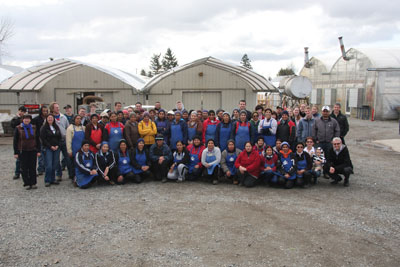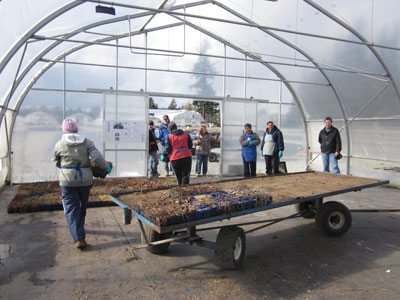
We know it works well in manufacturing plants… so how well would it work with greenhouse plants?
We know it works well in manufacturing plants… so how well would it work with greenhouse plants?
 |
|
| Members of the Valleybrook team in British Columbia. Advertisement
|
You may have heard the term “Lean” used before. Chances are you have heard it both as a positive and a negative. The passion associated with the word is simply from the experience that the individual has had with the application of this powerful quality improvement methodology.
I am Dale Schattenkirk and I would like to take you on a journey through several Lean projects that have been implemented in British Columbia with funding provided by Growing Forward, a federal-provincial-territorial initiative.
I am a Lean Six Sigma Black Belt and prac-titioner since 1999. I reside in Regina, or at least that’s where I keep my washing machine, and travel this fine country of ours helping organizations successfully implement change. During my journey I have been fortunate enough to work in many industries and receive accolades such as Industry Week’s top 10 plants and IPAC’s Lieutenant Governor’s award, both as a team member and a mentor.
HELPING COMPANIES APPLY THE METHODOLOGY
■ We specialize in teaching people to implement Lean on their own. Aristotle wrote that, “for the things we have to learn before we can do, we learn by doing.” This is what we practice – help people apply the methodology.
 |
|
| Applying Lean principals to ornamental horticulture. |
We jokingly state that we will “curse you,” and that “you will never look at anything the same again.” You won’t stand in line at a coffee shop without analyzing how the flow could be better, identifying mistake-proofing devices you have taken for granted, or changing the way you arrange your house!
Over the next four articles I will take you on a DMAIC journey of change. (DMAIC is an acronym that stands for Define, Measure, Analyze, Improve and Control.) This overarching methodology guides the Lean Six Sigma change process.
The project we worked on with Valleybrook Gardens, for example, focused on the “laying down” process.
“Laying down” is when you take potted plants and transfer them to the greenhouse, a very labour-intensive, time-consuming activity. I will walk you through the process of defining the scope of a project, measuring baseline, engaging staff, and achieving the significant savings that Valleybrook realized.
Valleybrook Gardens Ltd. was founded in 1980 by John and Kelly Schroeder. It is a wholesale nursery specializing in selling containerized perennials and related plants. The company has a diverse customer base located throughout Canada and the United States, focused primarily on the independent garden centre industry, with some exposure to mass-market retailers.
VALLEYBROOK PRODUCES OVER 2,000 DIFFERENT TYPES OF PRODUCTS
■ Valleybrook is the largest seller of perennials in Canada, owning some of the best-known brand names in the industry. In peak season, the company employs over 200 employees between its two locations in British Columbia and Ontario. Over 2,000 different types of products are produced each year, primarily in 9, 11 and 15 cm pots.
Through the story I will introduce you to Paula and Greg Baxter, the orchestrators of the Lean transformation at Valleybrook.
Having a Lean zealot is extremely important to getting a program started. Paula epitomizes the word “zealot.” She has drunk the “Kool-Aid,” sees where they can go using Lean, and is engaging everyone as she moves the program forward. Additionally, and equally as important, leadership has to buy-in, remove roadblocks, invest and have patience with the transformation.
Lean is not a magic wand that can be waved over an organization; it comes from commitment, knowledge and hard work.
When an organization calls for change, it’s easy to focus on the “people” and state things like “we don’t have enough staff” or “people have to work harder or smarter.” We call these statements symptoms of the problem.
ARE YOU USING MORE LABOUR THAN IS NECESSARY FOR SOME TASKS?
■ When you say you don’t have enough people, what you are really stating is the current process is designed to use more labour than necessary to complete the task. In all our years of process improvement we have not yet had to add people as a solution. We stand by the mantra of “there are no bad people, just bad processes.”
When we improve the incongruent processes, the work becomes easier, staff become happier, retention goes up, and engagement emerges.
The project that we will follow is the “laying down” process. It starts at the potting line as staff fill the trailers with specific plants to be sent out to the greenhouses. Once the trailer is filled, two people would drive the newly potted plants out to the appropriate location and then “lay them down.” Once the trailer(s) are empty the staff drives back and pick up the next trailer(s) and start the process all over again.
The issues with the current state were:
- Labour intensive.
- No clear understanding of location – the house could be full.
- Communication back and forth once the staff leave the potting line.
- ”Laying down” takes longer than potting, causing an imbalance in the process. Staff would have to stay long after the potting staff left.
In the next article I will walk you through the “Define and Measure” stage of the project.
Until then, keep improving.
| LTS AN AWARD-WINNING COMPANY Dale Schattenkirk, president/CEO of LTS Consulting, has over 12 years of experience in consulting, training, development and implementation of Lean Six Sigma methodology. He is an expert in transformational change and works with all levels of the organization from frontline staff to CEOs to teach them how to apply Lean Six Sigma in their settings and what it takes to be a leader in a Lean Six Sigma organization. He and his team were awarded the Lieutenant Governor’s Award of the Saskatchewan Regional group by the Institute of Public Administration of Canada (IPAC), for their success in the implementation of Lean Six Sigma within the Five Hills Health Region. He is also a recipient of Industry Week’s Top 10 Plant Award (team). Schattenkirk began his Lean Six Sigma Journey as a trainer with a local cable making company where he was selected and trained as the LSS facilitator for the organization and travelled around North America training employees and working with teams to implement organizational change. LTS Consulting began as a part-time venture for him. However, as demand has grown for a process improvement model successful in building an organization’s internal capacity for LSS improvement and producing quantitative results, the company expanded and was incorporated in 2006. LTS currently holds provincial contracts in six Canadian provinces. Schattenkirk is a certified Lean Six Sigma Black Belt, an ISO Auditor and a Certified Human Resources Professional (CHRP). |
Dale Schattenkirk is president/CEO of LTS Consulting and a certified Lean Six Sigma Black Belt, an ISO Auditor and a Certified Human Resources Professional (CHRP). • www.ltsee.com
Print this page